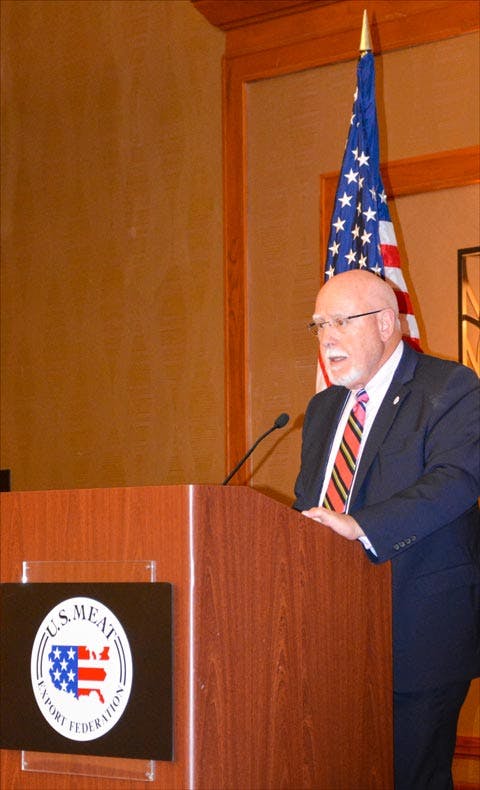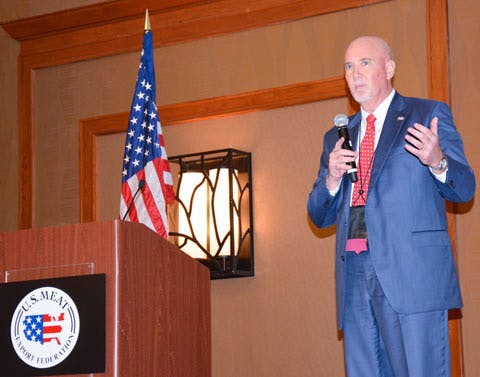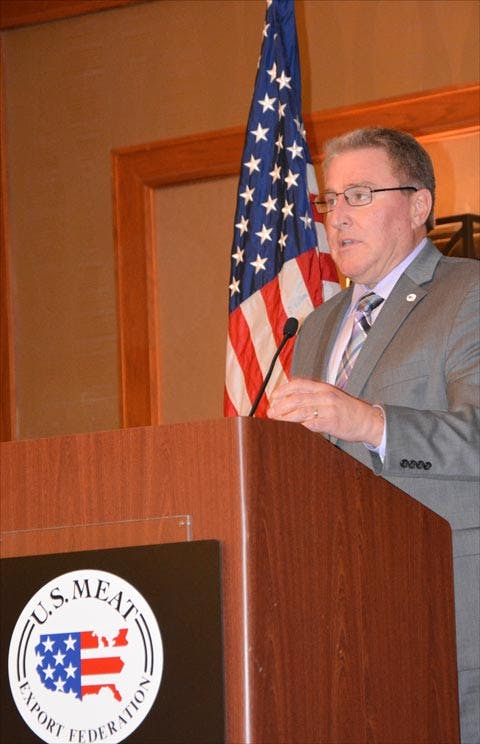USMEF Spring Conference Opens Big Week of Activities in Dallas
The USMEF Spring Conference was held Wednesday in Dallas, kicking off three days of meetings in tandem with the 2018 World Meat Congress – the premier gathering of global meat industry leaders.

USMEF Chair Dennis Stiffler welcomes members to the USMEF Spring Conference
USMEF Chair Dennis Stiffler opened the general session with a discussion of USMEF’s role in expanding global demand for U.S. red meat, noting that exports have continued to expand despite significant obstacles and an often uncertain trade environment.
“Whether it’s the renegotiation of the Korea-U.S. FTA, the ongoing negotiations surrounding NAFTA or other areas of uncertainty, these situations have the potential to disrupt trade,” Stiffler said. “But USMEF, our industry partners and all agricultural sectors have really worked in concert to reassure customers that the U.S. is a reliable supplier that values their business and their loyalty.”
USMEF President and CEO Dan Halstrom emphasized the communication and collaboration involved in achieving global expansion for U.S. beef, pork and lamb, thanking all of the agricultural sectors that support and participate in the federation, as well as the U.S. government agencies for their outstanding support and expertise in the trade arena. He concurred with Stiffler that, despite many areas of uncertainty, there is much for the red meat industry to look forward to in the international marketplace.

Ken Isley reflects on his first month as administrator of the USDA Foreign Agricultural Service
“I recently spoke at an industry conference that was titled ‘What Keeps Us Awake at Night When it Comes to Trade,’” Halstrom said. “But today I want to take a difference approach and talk about what helps me sleep well – including the underlying trends I see that suggest even better days are ahead for U.S. meat exports. Generic global population growth – already reaching 7.6 billion – as well as the continued growth of the middle class and rising disposable income. This is happening around the world, as we speak, and it spells opportunity as per capita consumption of red meat increases in many regions.”
The session's guest speaker was Ken Isley, who was recently chosen by Agriculture Secretary Sonny Perdue as administrator of the USDA Foreign Agricultural Service (FAS). Prior to taking this position, Isley served as special adviser for Corteva Agriscience, the agricultural division of DowDuPont. He previously served as vice president and general counsel for Dow AgroSciences, which was part of a 29-year career at Dow. Isley said his first month at FAS has proven to be a rewarding experience.

USMEF President and CEO Dan Halstrom discusses factors driving global demand for red meat
“When I considered accepting this appointment, I thought of three particular things that interested me,” he said. “First, it is a chance to serve our country. Second, it’s an opportunity to stay very engaged with the agricultural industry, and third it’s a chance to work with the current leadership at USDA – a group that is very committed to serving your interests. What I didn’t realize at the time was what an opportunity it is to work with a very talented, dedicated and experienced group at FAS. This is a group whose mission it is to grow exports and increase the prosperity of U.S. farmers and ranchers.”
To conclude the session, USMEF Senior Vice President for the Asia Pacific Joel Haggard offered a wide ranging view of emerging food and consumer trends in Asia, noting that many of them open up new opportunities for U.S. pork and beef.
“Our Asia directors, and in fact our entire Asia team, spend a lot of time discussing trends, fads and opportunities,” Haggard said. “Some of these trends fade out, but others take hold and really take off, and we want to make sure we identify the trends that have staying power that will create opportunities for U.S. products.”

Joel Haggard, USMEF senior vice president for the Asia Pacific, presents on emerging food trends in Asia
Haggard discussed the rapid growth of convenience store dining, as well as dining at food trucks and seeking home meal replacement items at retail. He noted that Asian consumers are choosing to dine in a much wider range of retail environments and often do so alone.
“In South Korea, for example, the percentage of single-person households has grown from 7 percent to 27 percent over the past 30 years, and it’s projected to reach 35 percent in another 15 years,” Haggard explained. “This is changing the way Korean consumers dine out. People going out to eat alone used to be a terrible experience, but restaurants are now being purpose-built for singles.”
Earlier in the day the USMEF Pork and Allied Industries Committee, the Beef and Allied Industries Committee, the Exporter Committee and the Feedgrain and Oilseed Caucus held meetings. These sessions included presentations on current marketing activities and market conditions from USMEF’s international staff, many of whom are hosting teams of buyers on U.S. visits in conjunction with the World Meat Congress. USMEF will report on these committee meetings in more detail in upcoming editions of the USMEF Export Newsline.
On Thursday morning, U.S. Agriculture Secretary Sonny Perdue will deliver the keynote address at the World Meat Congress. Attendees will also hear from Canadian Minister of Agriculture and Agri-Food Lawrence MacAulay and Luis Miguel Etchevehere, Argentina’s minister of agro-industry. For more details, visit www.2018wmc.com.
